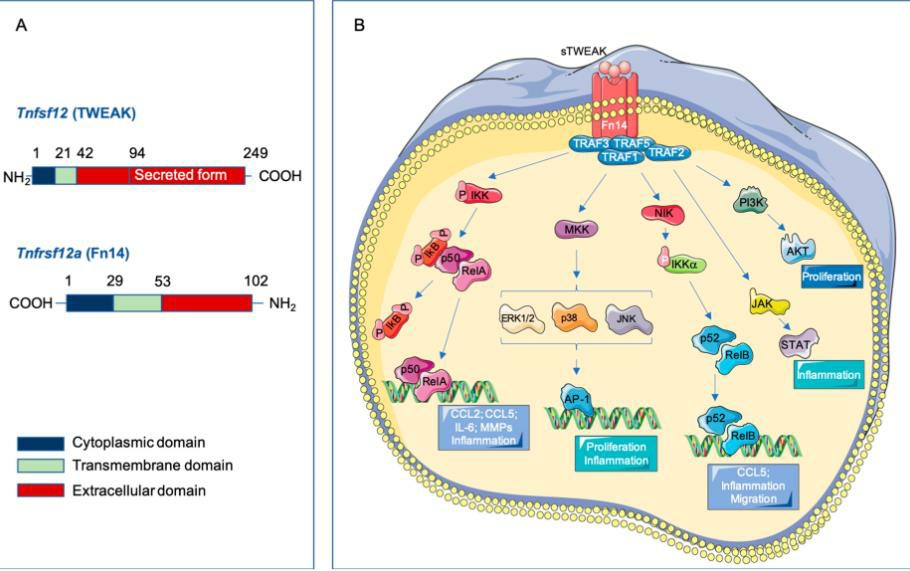What is TNFRSF12A Protein?
The TNFRSF12A protein is a monumental discovery with significant potential for understanding human health and diseases. Discovered as a part of an ongoing series of human genome projects, the TNFRSF12A protein is encoded by the gene TNFRSF12A (Tumor Necrosis Factor Receptor Superfamily Member 12A), also known as the FN14 gene.
Background and Gene Locus
The study of the human genome has provided a wealth of information about biological function and the mechanisms underlying disease. Among many key findings, the TNFRSF12A gene was located on the long arm of chromosome 16, specifically at locus 16q13. Initiated to kick-start a gene-to-protein investigation, the focus was on the comprehensive understanding of the gene's translation into the TNFRSF12A protein and the subsequent implications it has on human health.
Protein Structure
The TNFRSF12A protein features a compact structure like that of many proteins in the tumor necrosis factor receptor superfamily. Its structure consists of 129 amino acids and belongs to the TNFR superfamily, subfamily I, characterized by several cysteine-rich domains.
Function of TNFRSF12A Protein
The TNFRSF12A protein plays a critical role in several biological activities. It is particularly known to mediate cellular responses to tissue injury and serves as the primary receptor for TWEAK (TNF-like weak inducer of apoptosis), where complex interactions result in the stimulation of numerous pathways, primarily those which regulate cellular proliferation, migration, differentiation, and death.
TNFRSF12A Protein Related Signal Pathway
The significant function of the TNFRSF12A protein is to transmit cellular signals for growth, survival, and differentiation. Following the binding of TWEAK, the TNFRSF12A protein activates multiple signaling pathways, including the nuclear factor kappa-B (NF-κB) pathway, MAPK pathway, and various intracellular pathways that facilitate cell survival or apoptosis. These pathways are critical for the inflammatory responses, cell proliferation, migration, and angiogenesis.

Fig1. Tumor necrosis factor-like weak inducer of apoptosis (TWEAK)/ fibroblast growth factor-inducible 14 (Fn14) Signaling
TNFRSF12A Protein Related Diseases
Given its roles in various biological processes, the altered expression or dysfunction of the TNFRSF12A protein could contribute to several pathological conditions. Higher expression levels of TNFRSF12A have been found in several types of cancer, such as in glioblastoma, melanoma, bladder, and breast cancer.
Besides, TNFRSF12A also contributes to immune and inflammatory diseases, primarily due to its role in activating the NF-kB pathway involved in inflammatory responses. Therefore, the abnormal expression of this protein can contribute to autoimmune diseases such as rheumatoid arthritis, systemic lupus erythematosus (SLE), multiple sclerosis, and even allergic asthma.
TNFRSF12A Protein's Applications in Biomedicine
The myriad roles played by the TNFRSF12A protein and its capacity to influence different diseases have ignited interest in its potential as a therapeutic target in biomedicine. In cancer therapies, the high expression levels of TNFRSF12A in malignant tumors signify its potential as a cancer biomarker. Additionally, the use of TNFRSF12A inhibitors could be a potential strategy to suppress tumor growth and to enhance the effectiveness of chemotherapy or radiation therapy.
In the realm of inflammatory and autoimmune diseases, controlling TNFRSF12A activity might help manage symptoms or arrest disease progression. Studies are ongoing to explore the role of TNFRSF12A in neurodegenerative diseases as well, given the protein's connection to inflammatory responses in the central nervous system.
In conclusion, the TNFRSF12A protein, with its wide-ranging functions and potential pathological implications, holds great promise for future biomedical applications. Harnessing its potential through targeted therapeutics can pave the way for significant advancements in disease management and treatment. As more is discovered about this intriguing protein, the human quest for health and longevity may be significantly bolstered.
Our Featured Products
| Cat.No. | Product Name | Species | Source (Host) | Tag |
|---|---|---|---|---|
| TNFRSF12A-709H | Active Recombinant Human TNFRSF12A, Fc-tagged, Biotinylated | Human | Human Cell | Fc |
| TNFRSF12A-7734H | Recombinant Human TNFRSF12A protein, His & GST-tagged | Human | E.coli | His/GST |
| TNFRSF12A-582H | Recombinant Human TNFRSF12A protein | Human | E.coli | N/A |
| Tnfrsf12a-2085M | Recombinant Mouse Tnfrsf12a, Fc Chimera | Mouse | HEK293 | Fc |
| TNFRSF12A-1646R | Recombinant Rhesus Monkey TNFRSF12A Protein, hIgG1 tagged | Rhesus monkey | HEK293 | hFc |
Reference
- L., J., & M., L. (2020). Tumor Necrosis Factor-Like Weak Inducer of Apoptosis (TWEAK)/Fibroblast Growth Factor-Inducible 14 (Fn14) Axis in Cardiovascular Diseases: Progress and Challenges. Cells, 9(2), 405. https://doi.org/10.3390/cells9020405


